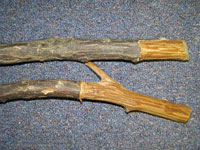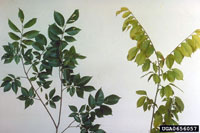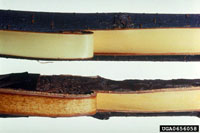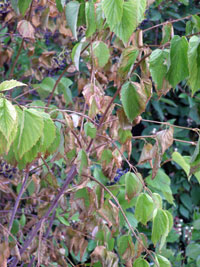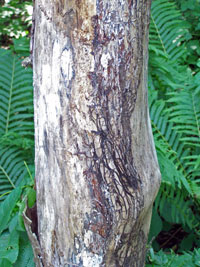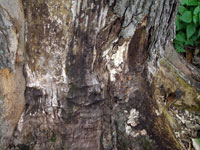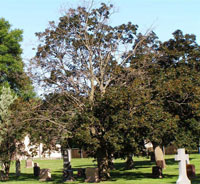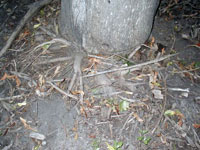Extension > Garden > Diagnose a problem > What's wrong with my plant? > Deciduous Trees > Elm > Leaves in the entire canopy yellow
Elm > Leaves > Leaves in the entire canopy yellow
1 of 4
Dutch elm disease
Ophiostoma ulmi and Ophiostoma novo-ulmi
- Leaves turn yellow, wilt or shrivel, turn brown, then fall off the branch
- Initial infection occurs on one branch; disease may quickly progress to all branches
- Peel back bark on symptomatic branch to reveal brown streaking on wood
- Healthy elms neighboring infected elms soon show symptoms due to spread through root grafts
- Wood pecker holes with bark loss is common on trees killed by Dutch Elm Disease
- American, red or slippery and rock elm are highly susceptible
- More information on Dutch elm disease
2 of 4
Elm yellows or Elm phloem necrosis
Elm yellows group or clover proliferation group
- Leaves in the entire canopy turn yellow, droop and fall off, often all in a few weeks time
- Occasionally, leaves can shrivel, turn brown and remain attached to branches for several weeks
- When bark is peeled back, the inner bark is yellow brown and smells of wintergreen (American elm) or maple syrup (red elm)
- Witches’ broom or dense leaf clusters at branch ends, common on red elms
- Damage appears mid to late summer; infected trees die within a year or two
- All Minnesota elm species are susceptible
- More information on Elm yellows
3 of 4
Armillaria root rot
Armillaria spp.
- Infected trees have poor growth, dead branches in the upper canopy, undersized and/or yellow leaves
- Flat white sheets of fungal mycelia (mycelia fans) grow between the bark and sapwood at the base of infected trees
- Thick, black, shoestring-like fungus that can possibly be seen under the bark, around roots and in soil around the tree base
- Wood is decayed, white, soft and spongy and may extend from the base of the tree well up into the trunk. Trees frequently break or fall over in storms
- Clusters of honey-colored mushrooms may grow at the base of the tree in fall
- More information on Armillaria root rot
4 of 4
Stem girdling roots
- Affected trees commonly exhibit excessive and abnormal winter damage including frost cracks and dieback
- Affected trees are often stunted, exhibit poor summer color, change color and lose their leaves early in the fall
- A root circling the trunk of the tree may be seen at the soil line
- Trunk may become sunken in or compressed where it contacts the root
- If girdling root is below ground, the trunk will lack the natural widening or flare at the soil line so will go straight into the earth like a telephone pole; trees often exhibit an abnormal lean
- Affected trees commonly exhibit water-stress symptoms such as marginal leaf scorch, wilting, sudden leaf fall
- More information on Stem girdling roots





